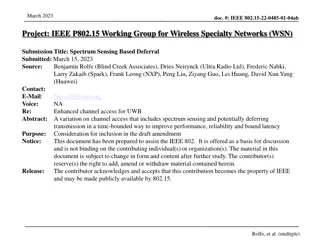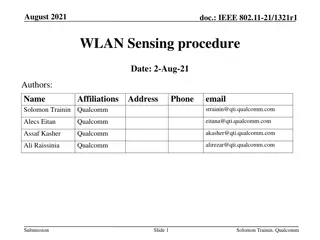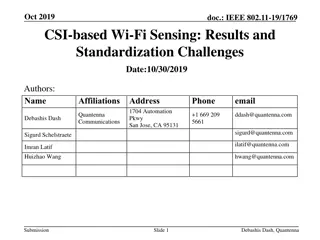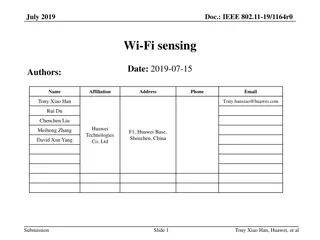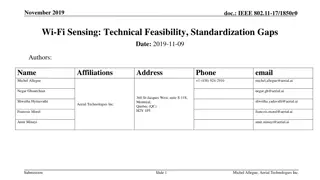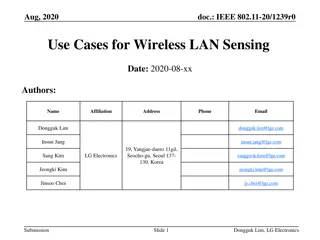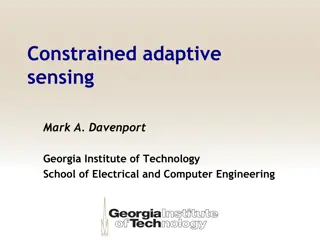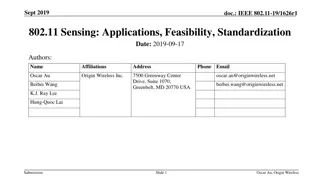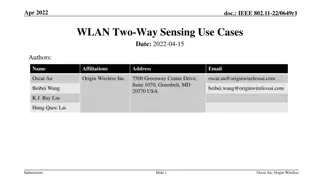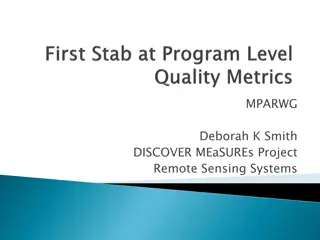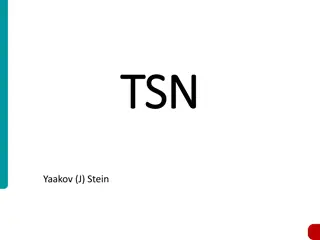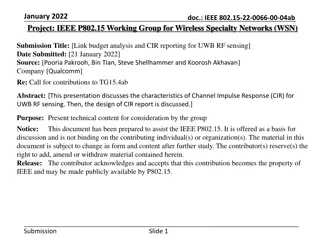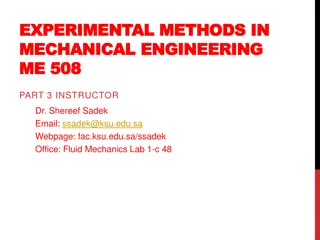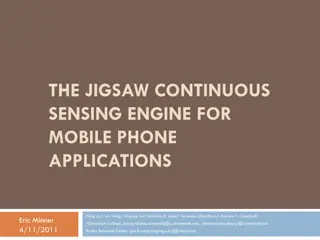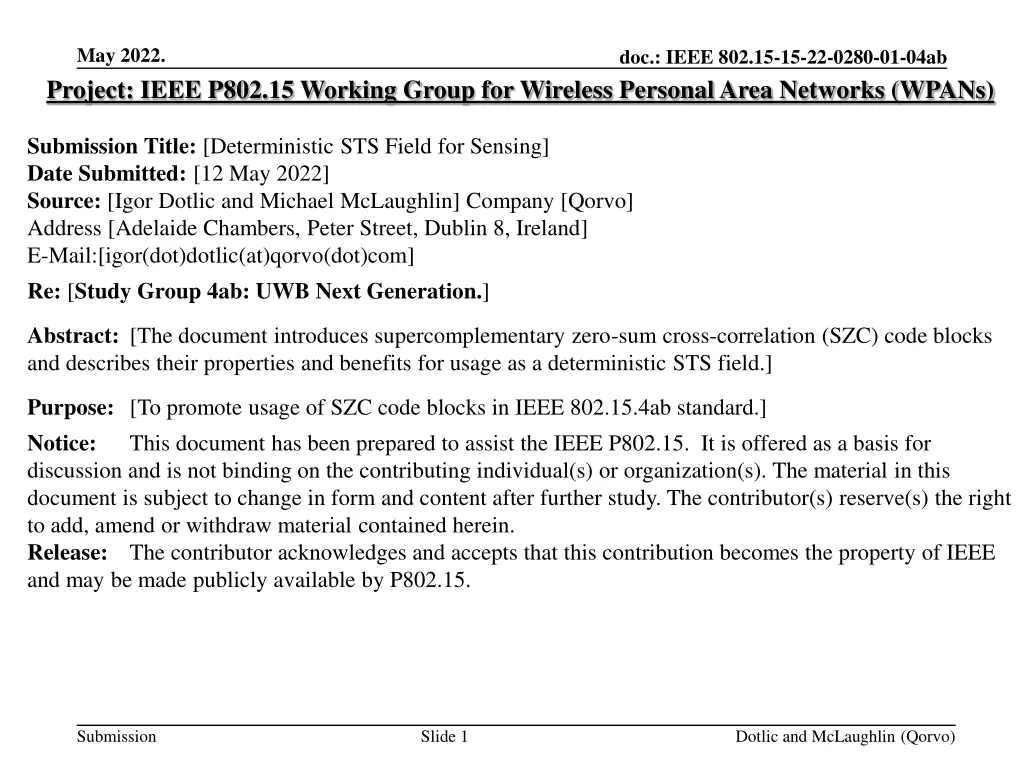
Deterministic STS Field for Sensing
"Introducing supercomplementary zero-sum cross-correlation (SZC) code blocks for usage as a deterministic STS field in IEEE 802.15.4ab standard to improve CIR estimation and reduce complexity and power consumption."
Download Presentation

Please find below an Image/Link to download the presentation.
The content on the website is provided AS IS for your information and personal use only. It may not be sold, licensed, or shared on other websites without obtaining consent from the author. If you encounter any issues during the download, it is possible that the publisher has removed the file from their server.
You are allowed to download the files provided on this website for personal or commercial use, subject to the condition that they are used lawfully. All files are the property of their respective owners.
The content on the website is provided AS IS for your information and personal use only. It may not be sold, licensed, or shared on other websites without obtaining consent from the author.
E N D
Presentation Transcript
May 2022. Project: IEEE P802.15 Working Group for Wireless Personal Area Networks (WPANs) doc.: IEEE 802.15-15-22-0280-01-04ab Submission Title: [Deterministic STS Field for Sensing] Date Submitted: [12 May 2022] Source: [Igor Dotlic and Michael McLaughlin] Company [Qorvo] Address [Adelaide Chambers, Peter Street, Dublin 8, Ireland] E-Mail:[igor(dot)dotlic(at)qorvo(dot)com] Re: [Study Group 4ab: UWB Next Generation.] Abstract: [The document introduces supercomplementary zero-sum cross-correlation (SZC) code blocks and describes their properties and benefits for usage as a deterministic STS field.] Purpose: [To promote usage of SZC code blocks in IEEE 802.15.4ab standard.] Notice: This document has been prepared to assist the IEEE P802.15. It is offered as a basis for discussion and is not binding on the contributing individual(s) or organization(s). The material in this document is subject to change in form and content after further study. The contributor(s) reserve(s) the right to add, amend or withdraw material contained herein. Release: The contributor acknowledges and accepts that this contribution becomes the property of IEEE and may be made publicly available by P802.15. Submission Slide 1 Dotlic and McLaughlin (Qorvo)
May 2022. doc.: IEEE 802.15-15-22-0280-01-04ab PAR Objective Safeguards so that the high throughput data use cases will not cause significant disruption to low duty-cycle ranging use cases Interference mitigation techniques to support higher density and higher traffic use cases Using fixed aperiodic STS field with a scrambling sequence. Other coexistence improvement Backward compatibility with enhanced ranging capable devices (ERDEV Slight modification of the 4z STS field. Improved link budget and/or reduced air-time Additional channels and operating frequencies Improvements to accuracy / precision / reliability and interoperability for high-integrity ranging Improves CIR estimation by virtue of the favourable properties of the proposed STS field. Reduced complexity and power consumption No need for AES block to run. Hybrid operation with narrowband signaling to assist UWB Enhanced native discovery and connection setup mechanisms Sensing capabilities to support presence detection and environment mapping Improve CIR estimation under Rx signal deformations. Low-power low-latency streaming Higher data-rate streaming allowing at least 50 Mbit/s of throughput Support for peer-to-peer, peer-to-multi-peer, and station-to-infrastructure protocols Infrastructure synchronization mechanisms Submission Slide 2 Dotlic and McLaughlin (Qorvo)
May 2022. doc.: IEEE 802.15-15-22-0280-01-04ab Deterministic STS Field for Sensing Why the STS Field Replacement for Sensing should be Deterministic and Aperiodic? Slide 3 Submission Dotlic and McLaughlin (Qorvo)
May 2022. doc.: IEEE 802.15-15-22-0280-01-04ab What do we want from our Channel Sounding Sequences for Sensing? Produce minimal interference to all other devices (sensing / ranging / data). Have a channel estimate that is maximally valid. Targets may produce small changes in the CIR packet-to- packet. Be resilient to interference. Unwanted receptions should produce minimal artefacts in the channel estimate, not to be mistaken for targets. Have minimal correlation artefacts in the presence of systematic Rx signal deformations as: Carrier frequency offset (CFO), if not removed before the correlation. Video clipping a weak path almost completely shadowed by a stronger path due to the low ADC resolution. Submission Slide 4 Dotlic and McLaughlin (Qorvo)
May 2022. doc.: IEEE 802.15-15-22-0280-01-04ab Side Note: CFO Removal after Correlation. Why? Analog RF and BB I/Q CFO removal (loop) Correlator Accumulator sampling CFO is removed after correlation and before accumulation on per-symbol basis. This makes needed bit-width in the correlator the same as the input ADC. Savings in the correlator power and area (one large digital block). Savings in the CFO removal power and area the whole symbol is rotated by the same angle. Submission Slide 5 Dotlic and McLaughlin (Qorvo)
May 2022. doc.: IEEE 802.15-15-22-0280-01-04ab Option 1: Replace STS Field with Repetitive Ipatov Codes. Ipatov codes have perfect periodic autocorrelation (PACR). The energy of periodic cross-correlation (PCCR) between any two codes from the same family is the same as the energy of PACR: Any transmission using the same code family and symbol length has a potential to produce high correlation artefacts. If used in the victim SHR, probability of false preamble detections rises. Possible mitigation techniques are those in frequency offset: baseband (previously proposed) and carrier. Perfect PACR holds only at CFO = 0. As CFO rises, so do the correlation sidelobes. To remove the edge effects, first symbol pre-cursors and final symbol post-cursors need to be correlated and accumulated. Submission Slide 6 Dotlic and McLaughlin (Qorvo)
May 2022. doc.: IEEE 802.15-15-22-0280-01-04ab Option 2: Fixed Aperiodic STS. Definitions: In STS code matrix every row represents a symbol. If STS code matrix is transmitted without any gap between symbols (as in 4z), it is called a code block. If just 4z STS Key and IV are fixed there will be considerable sidelobes. STS code block should be designed not to produce any sidelobes, i.e., for its symbols to complement completely after correlation. Moreover, complete complementing should hold under conditions of received code deformation which is consistent from symbol to symbol, e.g., CFO. Such code matrices, transmitted with a gap longer than the CIR are called supercomplementary sets of sequences (SSS) [1]. Generally, supercomplementarity does not hold when there is no gap between symbols, i.e., when we have a code block. We have found a way to have supercomplementary code blocks under conditions of the CIR duration being less or equal to the symbol duration. We call such code blocks supercomplementary zero-sum cross-correlation (SZC) code blocks. [1] S. Budisin, Supercomplementary sets of sequences, ElectronicsLetters, vol. 23, pp. 504 506, 05 1987. Submission Slide 7
May 2022. doc.: IEEE 802.15-15-22-0280-01-04ab SZC Construction For our purpose we use a binary ( 1)? ? Hadamard matrix ? which is SSS. Construct a SZC block as ? =? with every second symbol (row) inverted. ? will be a SZC if pre-cursors of the first symbol and the post-cursors of the last symbol are correlated with the last symbol and the first symbol, respectively. ? can be designed to have low sidelobes (? > 16) or zero sidelobes (? = 8, ? = 16), but not to be SZC, i.e., sidelobes level will increase with CFO. Designing ? to have low or zero sidelobes is not necessary for ? to be SZC but is desirable in cases when only ? symbols are transmitted. ?, where ? represents ? Submission Slide 8 Dotlic and McLaughlin (Qorvo)
May 2022. doc.: IEEE 802.15-15-22-0280-01-04ab Important SZC Properties ? can be repeated arbitrary number of times and will remain SZC. An arbitrary 1 ? vector ? can be chosen and each symbol of ? multiplied element-wise with it and ? will remain SZC. ?is called scrambling vector and in our case will be ternary 0, 1 , to keep the ternary nature of the transmitter. Zeros in ? are used to lower PRF, possibly with non- uniform grids. 1s in ? are used to scramble symbols, i.e., to make the same symbols of different transmissions correlate less. Submission Slide 9 Dotlic and McLaughlin (Qorvo)
May 2022. doc.: IEEE 802.15-15-22-0280-01-04ab Example Design For PRF = 128 MHz chose ? = 64, with ? = 4, i.e., symbol duration of 512 ns. For ? = 64, 4152 unique ? matrices were found with sidelobes level of four (-60 dB), but a single matrix should be sufficient for the standard. ? duration will be ?2= 4096 chips, or about 32 ?s. Minimal ? duration will be 2?2= 8192 chips, or about 64 ?s. For different networks use different ?. Lower PRFs are obtained by putting zeros in ?, possibly non-uniformly. Alternative: If CIR duration estimate of 1024 ns is needed, use ? = 64 with average ? = 8 for PRF = 64 MHz. Expansion from ? = 4 to ? = 8 does not have to be uniform, i.e, 64 ? columns can be placed on a grid of 128 possible positions non-uniformly with zeros in between. Submission Slide 10 Dotlic and McLaughlin (Qorvo)
May 2022. doc.: IEEE 802.15-15-22-0280-01-04ab Conclusions Proposed SZC code blocks allow for full complementing under deformations that are consistent from symbol to symbol, most prominent one being CFO. Interference mitigation is achieved both by the aperiodic nature of the SZC code blocks and by using scrambling. Changes to the current 4z STS receiver signal processing should be minimal: Instead of fetching symbols from AES, they are generated by using a simple logic from ? matrix and ?vector located in the memory. Symbol sizes should be fixed to either 512 ns or 1024 ns, which are integer divisors of all possible 4z STS sizes and reasonable expected CIR durations. Even though the focus here is on sensing, SZC code blocks can be used for precise ranging, in scenarios in which STS resilience to different attacks is not important (AES Key/IV exchange not needed). Submission Slide 11 Dotlic and McLaughlin (Qorvo)



